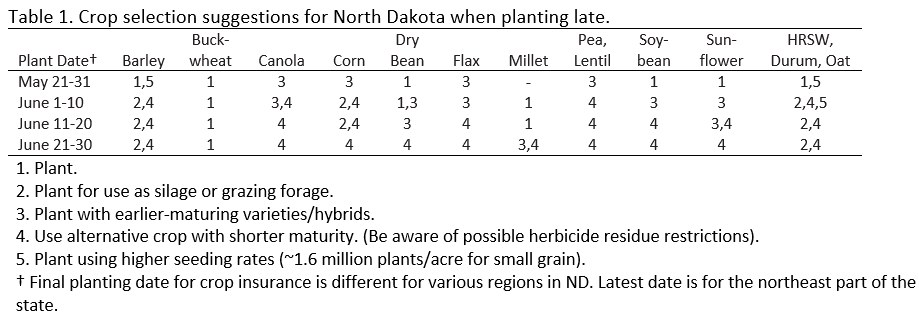Late Start of the Planting Season (05/26/22)
We have a late start to the planting season but adequate soil moisture is present. With high commodity prices, profit margins are good, even with reduced yields due to later than normal planting. Though seed yield potential likely is reduced with delayed planting of our cool-season crops, we possibly may have an adequate growing season for corn and soybean. Favorable soil and air temperatures, adequate soil moisture, and sufficient time for crop maturity before frost would be desirable.
A crop planted late in the season will germinate rapidly as the soil and air temperatures have increased. The most critical factor will be the growing season temperatures. Above average temperatures early in the season, generally are beneficial but can reduce yield with small grain if occurring during the 3- to 5-leaf stages, and detrimental during flowering and seed fill of all crops. Increasing the seeding rate slightly, as the season advances, would be a good strategy as there is less time left for crops to compensate for adverse growing conditions.
With late seeding, there is a potential danger that the crop will not mature before the fall frost. Average temperatures drop about 10 degrees from the middle of August until the middle of September. The day length during the middle of September is about three hours less than the longest day. A growing crop makes less progress to maturity in one day during the middle of September than in the middle of August. A crop seeded late may take twice as many fall days toward maturity compared with a crop seeded at the normal time. For instance, while there may only be four or five days difference in maturity between flax varieties when planted at the optimum time the difference may be 10 or more days when sown late. The approximate number of days from emergence to maturity of various crops sown in a normal season are buckwheat 70 days, flax 85 to 92 days, pinto beans 80 to 84 days, soybean 110-120 days and sunflower 105-110 days.
A number of factors impact the decision of what crop to plant or change to another crop. Many of these factors deal with issues that are not necessarily biological in nature. As examples, crop insurance, equipment availability, high market prices, availability of fertilizer, herbicides or seed, and past experience with the crop are some of the factors that are carefully considered before a decision is made as to what crop to plant.
Table 1 provides some suggestions on which crops might be most appropriate for a late planting situation. For additional information see NDSU Extension Publication A-934, Replanting or Late Planting Crops https://www.ndsu.edu/agriculture/ag-hub/publications/replanting-or-late-planting-crops

Extension Agronomist Broadleaf Crops
Extension Cropping Systems Specialist
NDSU Carrington Research Extension Center